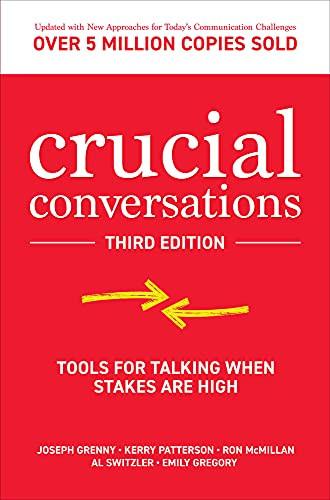Explore the World's Best Ideas
Join today and uncover 100+ curated journeys from 50+ topics. Unlock access to our mobile app with extensive features.
The Pool of Shared Meaning
- This is all the shared knowledge in a conversation. It’s a key part of having crucial conversations. The pool of shared meaning is a measure of a group’s shared IQ. The more information in the pool, the better their decisions.
- But it’s important to remember that it’s the overall amount of information in the pool that’s important. One dominant person shouldn’t control it. Other people’s contributions are just as valuable.
- People are also more likely to follow through on a conversation they’ve contributed to. They feel that they’re working towards a common goal.
202
2.26K reads
Crucial Conversations Start With Examining Yourself
How did people communicate when you were growing up? Was there debating or shouting or silent treatment? How do you respond to conflict? Do you shut down or lash out?
- The styles of communication you were exposed to as a child affect how you communicate now.
- Despite sometimes feeling helpless, we’re rarely powerless to influence our circumstances. We don’t like to admit it, but we often contribute to our issues, even when we don’t realize we’re doing it.
- It’s not about being to blame. It’s about learning to take control of your life and conversations.
212
1.68K reads
Stay Focused
When you’re in a crucial conversation, it’s easy for high stakes to get the better of you and for things to blow up. You lose focus.
A great way to avoid this is by setting yourself a clear goal for the conversation.
Another way to focus your mind is to ask yourself:
- What do they want for/from me?
- What do I want for them?
- What don’t I want from this?
- How do I avoid that?
These simple questions will help you empathize with the other person, pre-solve any challenges and have better, more constructive conversations.
228
1.49K reads
Style Under Stress
Crucial conversations can be frightening. When we get scared, we typically turn to one of two “Styles Under Stress”: Silence or Violence.
Silence behaviors include:
- Masking: Hiding your true opinion through sarcasm or sugarcoating;
- Avoiding: Steering away from the conversation topic; and
- Withdrawing: Pulling out of the conversation by changing the topic or leaving.
Violence behaviors include:
- Attacking: Belittling or threatening;
- Controlling: Coercing others into your way of thinking, cutting people off, exaggerating your facts, or speaking in absolutes; and
- Labeling: Dismissing something by associati
ng it with a stereotype.
222
1.43K reads
Pay Attention To How You Respond, and Why
These questions might help you better understand your behavior:
- When do you have outbreaks of your Style Under Stress?
- What situations do you find stressful? and
- What subjects do you find stressful?
Once you’ve learned to look at yourself you can start looking at other people.
Understanding their proclivity for violence or silence will help you to plan your approach.
195
1.21K reads
Make Sure Everyone Feels Safe To Take Part
You can do this through mutual respect and mutual purpose.
- To ensure mutual respect, ask: Do they believe you respect them?
- Apologize when appropriate.
To ensure mutual purpose, ask:
- Do you both trust each other’s motives in this conversation?
- Do they believe that you care about what they have to say?
186
1.14K reads
The Stories We Tell
The most common stories are:
- Victim Stories: they ignore your responsibility for causing the problem;
- Villain Stories: they make the problem someone else’s fault; and
- Helpless Stories: they make us feel powerless to fix the situation.
These stories assume the worst about ourselves and the people around us. These stories lead to silence or violence.
188
1.11K reads
STATE My Path
We need to develop five distinct skills.
We need to STATE:
- Share your facts – Start with your least controversial points. Ease them into the conversation.
- Tell your story – Explain your perspective. Where do you think the conversation is going?
- Ask for others’ paths – Allow others to share what they think and want from the conversation.
- Talk tentatively – Don’t treat your perspective as fact. Remember it’s your story. It might not be anyone else’s
- Encourage testing – Let others challenge your points. Their opinions have value and could help you find the truth.
224
1.02K reads
Explore Others’ Paths
To encourage other people to share, try AMPP:
- Ask questions – Get things moving with questions. They show you’re interested and help others contribute.
- Mirror feelings – Let others know you recognize what they’re feeling e.g. “I can hear that you’re upset about that” or “It sounds like you want to make a change.”
- Paraphrase to show understanding – Show you understand by putting what they’ve said in your own words e.g. “To make sure I’ve got this right; you want to…”
- Prime when you’re unsure – Make an educated guess when they give you nothing e.g.”I would feel sad about that. What about you?”
One more
Agree – Tell them what you do agree with. Build – Build on what they’ve said. Compare – Compare and contrast when you completely disagree.
220
920 reads
There Are Four Ways of Making Decisions As A Group
- Command – If you know what you want, give clear instructions. The best way to do this is to phrase a request. It also helps to give reasons.
- Consult – Decisions are better when everyone inputs. Only use this if you need outside input; don’t pretend. When you make a decision, report it to everyone you’ve asked.
- Vote – Votes should never replace healthy dialogue and analysis. But they can be great for either/or decisions.
- Consensus – This is where everyone comes to the same decision. Don’t force it. These need to happen naturally to be sure everyone agrees.
190
952 reads
IDEAS CURATED BY
Linda Thompson's ideas are part of this journey:
Learn more about books with this collection
How to manage workplace stress
How to prioritize and make better decisions
How to learn anything fast
Related collections
Different Perspectives Curated by Others from Crucial Conversations: Tools for Talking When Stakes are High, Third Edition
Curious about different takes? Check out our book page to explore multiple unique summaries written by Deepstash curators:
Discover Key Ideas from Books on Similar Topics
15 ideas
Reflections on the Revolution in France
Edmund Burke (III)
9 ideas
7 ideas
Ask Powerful Questions
Will Wise
Read & Learn
20x Faster
without
deepstash
with
deepstash
with
deepstash
Personalized microlearning
—
100+ Learning Journeys
—
Access to 200,000+ ideas
—
Access to the mobile app
—
Unlimited idea saving
—
—
Unlimited history
—
—
Unlimited listening to ideas
—
—
Downloading & offline access
—
—
Supercharge your mind with one idea per day
Enter your email and spend 1 minute every day to learn something new.
I agree to receive email updates

